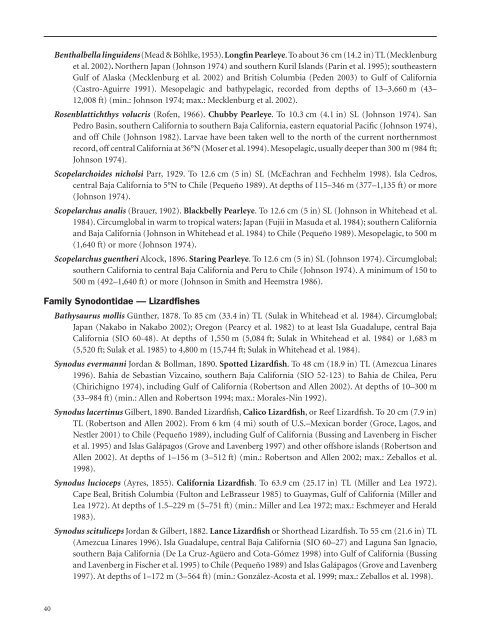Untitled - Alaska Resources Library
Untitled - Alaska Resources Library
Untitled - Alaska Resources Library
Create successful ePaper yourself
Turn your PDF publications into a flip-book with our unique Google optimized e-Paper software.
40<br />
Benthalbella linguidens (Mead & Böhlke, 1953). Longfin Pearleye. To about 36 cm (14.2 in) TL (Mecklenburg<br />
et al. 2002). Northern Japan (Johnson 1974) and southern Kuril Islands (Parin et al. 1995); southeastern<br />
Gulf of <strong>Alaska</strong> (Mecklenburg et al. 2002) and British Columbia (Peden 2003) to Gulf of California<br />
(Castro-Aguirre 1991). Mesopelagic and bathypelagic, recorded from depths of 13–3,660 m (43–<br />
12,008 ft) (min.: Johnson 1974; max.: Mecklenburg et al. 2002).<br />
Rosenblattichthys volucris (Rofen, 1966). Chubby Pearleye. To 10.3 cm (4.1 in) SL (Johnson 1974). San<br />
Pedro Basin, southern California to southern Baja California, eastern equatorial Pacific (Johnson 1974),<br />
and off Chile (Johnson 1982). Larvae have been taken well to the north of the current northernmost<br />
record, off central California at 36°N (Moser et al. 1994). Mesopelagic, usually deeper than 300 m (984 ft;<br />
Johnson 1974).<br />
Scopelarchoides nicholsi Parr, 1929. To 12.6 cm (5 in) SL (McEachran and Fechhelm 1998). Isla Cedros,<br />
central Baja California to 5°N to Chile (Pequeño 1989). At depths of 115–346 m (377–1,135 ft) or more<br />
(Johnson 1974).<br />
Scopelarchus analis (Brauer, 1902). Blackbelly Pearleye. To 12.6 cm (5 in) SL (Johnson in Whitehead et al.<br />
1984). Circumglobal in warm to tropical waters; Japan (Fujii in Masuda et al. 1984); southern California<br />
and Baja California (Johnson in Whitehead et al. 1984) to Chile (Pequeño 1989). Mesopelagic, to 500 m<br />
(1,640 ft) or more (Johnson 1974).<br />
Scopelarchus guentheri Alcock, 1896. Staring Pearleye. To 12.6 cm (5 in) SL (Johnson 1974). Circumglobal;<br />
southern California to central Baja California and Peru to Chile (Johnson 1974). A minimum of 150 to<br />
500 m (492–1,640 ft) or more (Johnson in Smith and Heemstra 1986).<br />
Family Synodontidae — Lizardfishes<br />
Bathysaurus mollis Günther, 1878. To 85 cm (33.4 in) TL (Sulak in Whitehead et al. 1984). Circumglobal;<br />
Japan (Nakabo in Nakabo 2002); Oregon (Pearcy et al. 1982) to at least Isla Guadalupe, central Baja<br />
California (SIO 60-48). At depths of 1,550 m (5,084 ft; Sulak in Whitehead et al. 1984) or 1,683 m<br />
(5,520 ft; Sulak et al. 1985) to 4,800 m (15,744 ft; Sulak in Whitehead et al. 1984).<br />
Synodus evermanni Jordan & Bollman, 1890. Spotted Lizardfish. To 48 cm (18.9 in) TL (Amezcua Linares<br />
1996). Bahia de Sebastian Vizcaino, southern Baja California (SIO 52-123) to Bahia de Chilea, Peru<br />
(Chirichigno 1974), including Gulf of California (Robertson and Allen 2002). At depths of 10–300 m<br />
(33–984 ft) (min.: Allen and Robertson 1994; max.: Morales-Nin 1992).<br />
Synodus lacertinus Gilbert, 1890. Banded Lizardfish, Calico Lizardfish, or Reef Lizardfish. To 20 cm (7.9 in)<br />
TL (Robertson and Allen 2002). From 6 km (4 mi) south of U.S.–Mexican border (Groce, Lagos, and<br />
Nestler 2001) to Chile (Pequeño 1989), including Gulf of California (Bussing and Lavenberg in Fischer<br />
et al. 1995) and Islas Galápagos (Grove and Lavenberg 1997) and other offshore islands (Robertson and<br />
Allen 2002). At depths of 1–156 m (3–512 ft) (min.: Robertson and Allen 2002; max.: Zeballos et al.<br />
1998).<br />
Synodus lucioceps (Ayres, 1855). California Lizardfish. To 63.9 cm (25.17 in) TL (Miller and Lea 1972).<br />
Cape Beal, British Columbia (Fulton and LeBrasseur 1985) to Guaymas, Gulf of California (Miller and<br />
Lea 1972). At depths of 1.5–229 m (5–751 ft) (min.: Miller and Lea 1972; max.: Eschmeyer and Herald<br />
1983).<br />
Synodus scituliceps Jordan & Gilbert, 1882. Lance Lizardfish or Shorthead Lizardfish. To 55 cm (21.6 in) TL<br />
(Amezcua Linares 1996). Isla Guadalupe, central Baja California (SIO 60–27) and Laguna San Ignacio,<br />
southern Baja California (De La Cruz-Agüero and Cota-Gómez 1998) into Gulf of California (Bussing<br />
and Lavenberg in Fischer et al. 1995) to Chile (Pequeño 1989) and Islas Galápagos (Grove and Lavenberg<br />
1997). At depths of 1–172 m (3–564 ft) (min.: González-Acosta et al. 1999; max.: Zeballos et al. 1998).
















